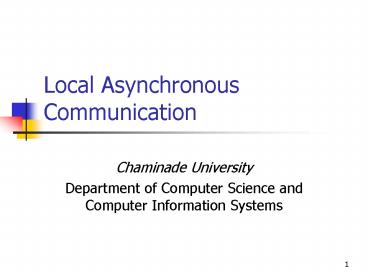Local Asynchronous Communication - PowerPoint PPT Presentation
1 / 21
Title:
Local Asynchronous Communication
Description:
Example: Keyboards use asynchronous communication. 3. Using voltage to send info. 4 ... Any transmission system that uses radio, waves, sound, light or electric ... – PowerPoint PPT presentation
Number of Views:40
Avg rating:3.0/5.0
Title: Local Asynchronous Communication
1
Local Asynchronous Communication
- Chaminade University
- Department of Computer Science and Computer
Information Systems
2
Asynchronous Communication
- A communication is called asynchronous if a
sender and a receiver do not need to coordinate
before data can be transmitted. - Transmitter and receiver do not synchronize
before each transmission. - Example Keyboards use asynchronous communication.
3
Using voltage to send info
4
The RS-232 Standard
- RS-232 is a popular standard used for
asynchronous, serial communication over short
distances between a computer and a modem or ASCII
terminal.
5
RS-232 Voltages
6
RS-232 Voltages
- Note that the sender must leave the line idle for
a minimum time after the transmission of the last
bit. This idle time is called the stop bit. - Because a receiver cannot distinguish between an
idle line and an initial 1 bit, the RS-232
standard requires a sender to transmit an extra 0
bit before transmitting the bits of a character.
The extra bit is known as a start bit.
7
Exercise
- Create the RS232 waveform diagram for the
transmission of the ASCII character a.
8
Baud Rate
- Transmission hardware is rated in baud, the
number of changes in the signal per second that
the hardware generates. - For the simple RS-232 protocol, the baud rate is
exactly equal to the number of bits per second. - Thus, 9600 baud means 9600 bits per second.
9
Wiring for Full-Duplex RS-232
10
Limitations of Real Hardware
- How fast can hardware transmit bits across a
wire? - No electronic device can produce an exact voltage
or change from one voltage to another instantly. - No wire conducts electricity perfectly
- Signals lose energy, signals are not perfect.
11
Example
12
Bandwidth
Sampling interval
An electric signal that is transmitted beyond the
bandwidth of the channel. Can you tell where is
the 1 and here is the 0 ? Can a receiver decode
the 1 and the 0 ?
13
Bandwidth
- Each transmission system has a limited bandwidth
- Bandwidth is the maximum rate that the hardware
can change the signal. - If the sender attempts to transmit changes faster
than the bandwidth, the hardware will not be able
to keep up because it will not have enough time
to complete one change before the sender
attempts to make another.
14
Bandwidth
- Bandwidth is measured in cycles per second, or
Hertz (Hz). - Bandwidth is the fastest continuously oscillating
signal that can be sent across the hardware. - Example A transmission system has BW of 4000Hz
the underlying HW can transmit any signal that
oscillates at a rate less than or equal to 4000
cycles per second.
15
Bandwidth
- Bandwidth limitations arise from the physical
properties of matter and energy. - Any transmission system that uses radio, waves,
sound, light or electric current will have a
limited bandwidth.
16
The Nyquist Theorem
- Relationship between the bandwidth (B) of a
transmission channel and the maximum number of
bits per second (D) that can be transferred over
that channel. Known as the Nyquist theorem. - It provides a theoretical bound on the maximum
rate at which data can be sent. - D 2Blog2 K
- K is the possible values of voltage used.
17
Exercise
- Working with a neighbor, find out the maximum
data rate that can be sent for a transmission
scheme like RS-232. - Determine the maximum rate in bits per second at
which data can be sent across a transmission
system that has a bandwidth of 4000 Hz and uses
four values of voltage to encode information.
18
The Shannons Theorem
- Nyquists theorem provides an absolute maximum
that cannot be achieved in practice. - Real communication systems are subject to small
amounts of background interference called noise. - Noise makes it impossible to achieve the
theoretical maximum transmission rate.
19
The Shannons Theorem
- The theorem can be stated as
- C Blog2 (1 S/N) where
- C is the effective limit
- S/N is the signal to noise ratio.
- The signal to noise ratio is given in decibels by
the expression 10log10S/N. - Example a ratio of S/N equal to 100 is 20 db.
20
Exercise
- The telephone system has a signal-to-noise ratio
of approximately 30db and a bandwidth of
approximately 3000 Hz. What is the data rate of
such a system? - Answer about 30,000 bps.
- How dialup modems achieve higher throughput than
the Shannon Theorem allows? - Answer Data Compression (only 6 bits are used to
send English letters)
21
(No Transcript)































